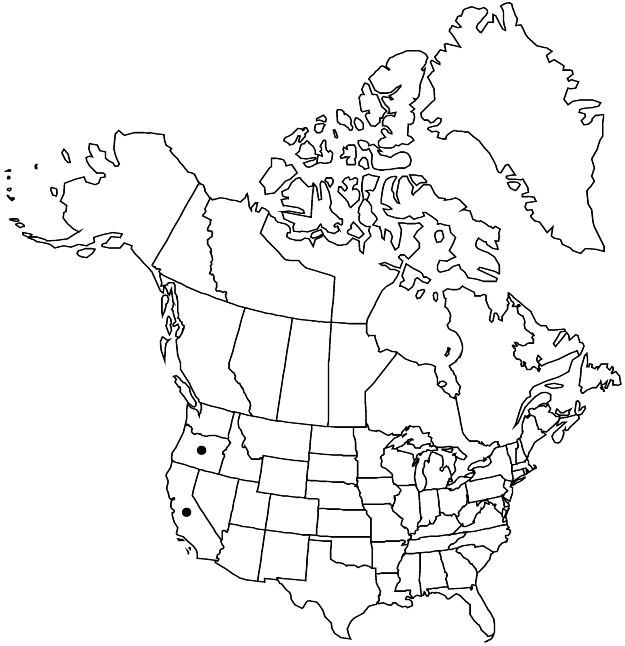Difference between revisions of "Silene bridgesii"
Index Seminum (Berlin), App. 2: 5. 1867.
FNA>Volume Importer |
imported>Volume Importer |
||
| (3 intermediate revisions by one other user not shown) | |||
| Line 8: | Line 8: | ||
}} | }} | ||
|common_names=Bridges’s catchfly | |common_names=Bridges’s catchfly | ||
| + | |special_status={{Treatment/ID/Special_status | ||
| + | |code=E | ||
| + | |label=Endemic | ||
| + | }} | ||
|basionyms= | |basionyms= | ||
|synonyms={{Treatment/ID/Synonym | |synonyms={{Treatment/ID/Synonym | ||
|name=Silene engelmannii | |name=Silene engelmannii | ||
|authority=Rohrbach | |authority=Rohrbach | ||
| + | |rank=species | ||
}} {{Treatment/ID/Synonym | }} {{Treatment/ID/Synonym | ||
|name=Silene incompta | |name=Silene incompta | ||
|authority=A. Gray | |authority=A. Gray | ||
| + | |rank=species | ||
}} {{Treatment/ID/Synonym | }} {{Treatment/ID/Synonym | ||
|name=Silene longistylis | |name=Silene longistylis | ||
|authority=Engelmann ex S. Watson | |authority=Engelmann ex S. Watson | ||
| + | |rank=species | ||
}} | }} | ||
|hierarchy=Caryophyllaceae;Caryophyllaceae subfam. Caryophylloideae;Silene;Silene bridgesii | |hierarchy=Caryophyllaceae;Caryophyllaceae subfam. Caryophylloideae;Silene;Silene bridgesii | ||
| Line 43: | Line 50: | ||
-->{{#Taxon: | -->{{#Taxon: | ||
name=Silene bridgesii | name=Silene bridgesii | ||
| − | |||
|authority=Rohrbach | |authority=Rohrbach | ||
|rank=species | |rank=species | ||
| Line 57: | Line 63: | ||
|publication title=Index Seminum (Berlin), App. | |publication title=Index Seminum (Berlin), App. | ||
|publication year=1867 | |publication year=1867 | ||
| − | |special status= | + | |special status=Endemic |
| − | |source xml=https:// | + | |source xml=https://bitbucket.org/aafc-mbb/fna-data-curation/src/2e0870ddd59836b60bcf96646a41e87ea5a5943a/coarse_grained_fna_xml/V5/V5_347.xml |
|subfamily=Caryophyllaceae subfam. Caryophylloideae | |subfamily=Caryophyllaceae subfam. Caryophylloideae | ||
|genus=Silene | |genus=Silene | ||
Latest revision as of 22:10, 5 November 2020
Plants perennial; taproot stout; caudex much-branched, woody. Flowering stems erect, with 3–6 pairs of leaves below inflorescence, 30–80 cm, short-pubescent, glandular and somewhat viscid distally. Leaves: proximal petiolate, blade oblanceolate, 3–6(–8) cm × 5–15 mm (including petiole), base tapered into short petiole, apex acute to obtuse and apiculate, short-pubescent on both surfaces, pubescence rather sparse adaxially; cauline leaves sessile, blade elliptic-lanceolate, 2–6 cm × 5–15 mm. Inflorescences branched, several–many-flowered, open, bracteate, flowering portion to 15 cm and ca. 1/2 as broad, glandular and viscid; cymules usually 1–3-flowered; bracts narrowly lanceolate, shorter than pedicel; peduncle shorter than internodes. Pedicels divaricate, sharply bent distally, 5–15 mm. Flowers nodding; calyx prominently 10-veined, tubular to campanulate, umbilicate but narrowed at base, lobed, 9–11 × 3–5 mm in flower, in fruit ovate to turbinate, 5–8 mm broad, viscid-pubescent, veins parallel, green, papery between; lobes 5, narrowly lanceolate, obtuse, 2–3 mm, ciliate; corolla ± white, often greenish abaxially and pink tinged, 2 times calyx; petals 2-lobed, margins entire to erose, appendages linear, narrow, 1–2.5 mm; stamens often long-exserted; filaments pubescent at base; styles persistent, 3, long-exserted, filamentous, exceeding 2 times calyx. Capsules broadly ovoid, ca. equaling calyx, opening by 6 ascending, triangular teeth; carpophore 2–3 mm. Seeds reddish brown, reniform, 1.2–1.8 mm broad, coarsely papillate. 2n = 48.
Phenology: Flowering summer.
Habitat: Coniferous forest openings and mixed woodlands, dry slopes
Elevation: 500-2800 m
Discussion
Silene bridgesii is similar to S. lemmonii but usually can be distinguished by its larger size, broader and larger leaves, the near-absence of sterile basal shoots, and larger floral parts and fruits. Although S. longistylis has often been cited as a synonym of S. lemmonii, examination of the holotype (Henderson s.n., GH) indicates that it is referable to S. bridgesii.
Silene bridgesii is found in the Sierra Nevada and southern Cascades.
Selected References
None.
